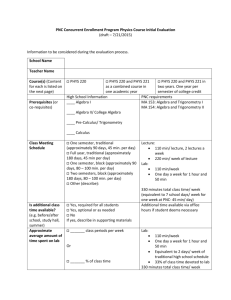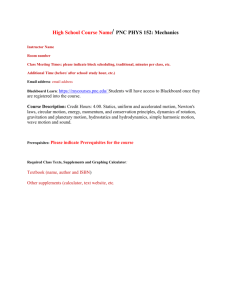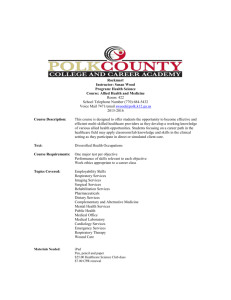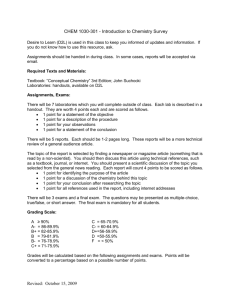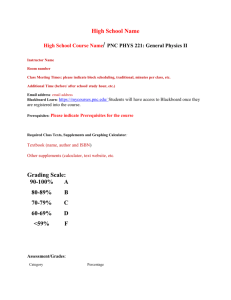PHYS 152 – create
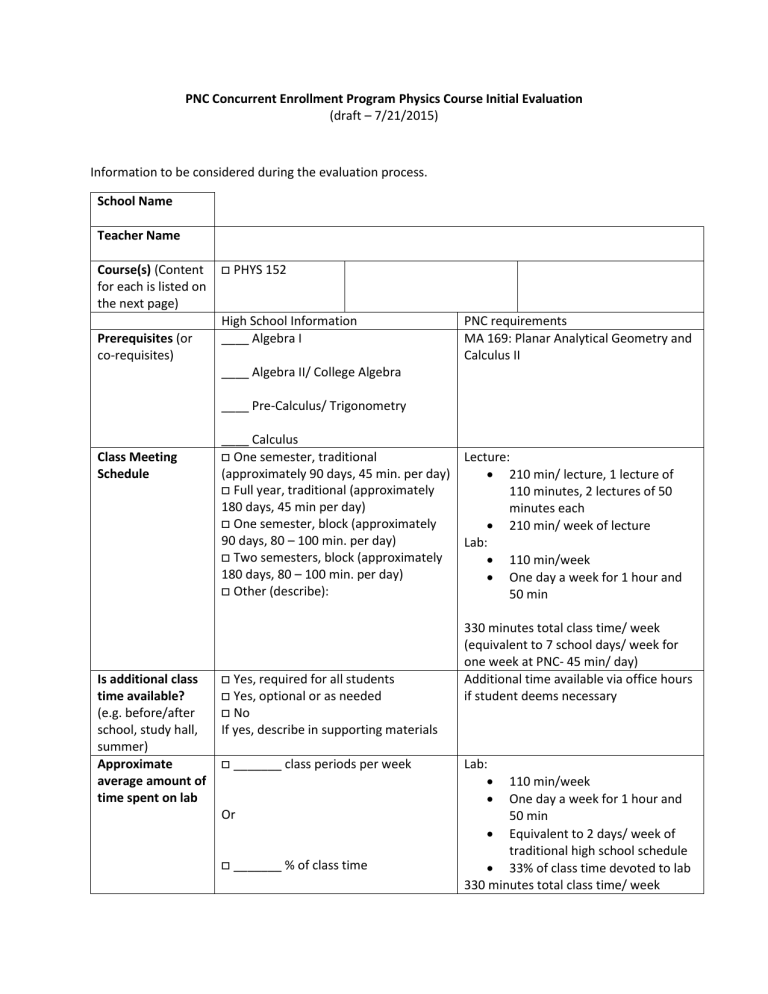
PNC Concurrent Enrollment Program Physics Course Initial Evaluation
(draft – 7/21/2015)
Information to be considered during the evaluation process.
School Name
Teacher Name
Course(s) (Content for each is listed on the next page)
Prerequisites (or co-requisites)
□ PHYS 152
Class Meeting
Schedule
Is additional class
time available?
(e.g. before/after school, study hall, summer)
Approximate average amount of time spent on lab
High School Information
____ Algebra I
____ Algebra II/ College Algebra
____ Pre-Calculus/ Trigonometry
____ Calculus
□ One semester, traditional
(approximately 90 days, 45 min. per day)
□ Full year, traditional (approximately
180 days, 45 min per day)
□ One semester, block (approximately
90 days, 80 – 100 min. per day)
□ Two semesters, block (approximately
180 days, 80 – 100 min. per day)
□ Other (describe):
□
□
Yes, required for all students
Yes, optional or as needed
□ No
If yes, describe in supporting materials
PNC requirements
MA 169: Planar Analytical Geometry and
Calculus II
Lecture:
210 min/ lecture, 1 lecture of
110 minutes, 2 lectures of 50 minutes each
210 min/ week of lecture
Lab:
110 min/week
One day a week for 1 hour and
50 min
330 minutes total class time/ week
(equivalent to 7 school days/ week for one week at PNC- 45 min/ day)
Additional time available via office hours if student deems necessary
□
□
_______ class periods per week
Or
_______ % of class time
Lab:
110 min/week
One day a week for 1 hour and
50 min
Equivalent to 2 days/ week of traditional high school schedule
33% of class time devoted to lab
330 minutes total class time/ week
Textbook used by
students: indicate one of the commonly used books or write in a different one, if necessary. (Since some authors write different textbooks for different levels, please check ISBNs)
□ Bauer, Wolfgang & Wesfall, Gary.
University Physics with Modern Physics,
McGraw Hill
□ Chabay, Ruth W., and Bruce A.
Sherwood. Electric and Magnetic
Interactions. New York: John Wiley &
Sons.
□ Chabay, Ruth W., and Bruce A.
Sherwood. Matter and Interactions I:
Modern Mechanics. New York: John
Wiley & Sons.
□ Chabay, Ruth W., and Bruce A.
Sherwood. Matter and Interactions II:
Electricity and Magnetic Interactions.
New York: John Wiley & Sons.
□ Giancoli, Douglas C., Physics for
Scientists and Engineers. Upper Saddle
River, NJ: Prentice Hall.
□ Halliday, David, Robert Resnick, and
Kenneth Krane. Physics. Vols. 1 & 2. New
York: John Wiley & Sons.
□ Halliday, David, Robert Resnick, and
Jearl Walker. Fundamentals of Physics.
New York: John Wiley & Sons. (or any variation on the Hallday text)
□ Hecht, Eugene. Physics: Calculus. New
York: Brooks/Cole.
□ Knight, Randall D. Physics for Scientists and Engineers: A Strategic Approach
with Modern Physics. Boston, MA:
Addison-Wesley.
□ Serway, Raymond A. Principles of
Physics. Fort Worth, TX: Saunder
University Physics, 13 th Ed, Young
Grading Scheme:
Indicate the percentage of the overall grade from each of the following components
(unused categories can be left blank)
□ Serway, Raymond A., Robert J.
Beichner and John W. Jewett, Jr. Physics
for Scientists and Engineer. Vols. 1 & 2.
Fort Worth, TX: Saunders.
□ Tipler, Paul A. Physics for Scientists
and Engineers. New York, NY: W. H.
Freeman.
□ Young, Hugh D., and Roger A.
Freedman. University Physics. Reading,
MA: Addison Wesley Longman.
□ Young, Hugh D., Roger A. Freedman,
T.R. Sandin, and A. Lewis Ford. Sears and
Semansky's University Physics. Reading,
MA: Addison-Wesley.
□ Other:
_______________________________
____ __
____ __
*Students should be using a collegelevel book. If a college-level book is not available until the next round of adoptions, the teacher should provide supplementary information to the students. If this is the case, please describe in the attached materials.
THE HIGH SCHOOL WILL BE
REQUIRED TO ADOPT THE PNC
GRADING CRITERIA
30%: 3 exams
20% Final Exam
20%: Lab
25% homework
5% in-class activities
Grading Scale:
Grading Policies:
(Check all that apply)
THE HIGH SCHOOL WILL BE
REQUIRED TO ADOPT THE PNC
GRADING SCALE.
□
□
Students must pass the laboratory portion of the course to pass the overall course
Students cannot receive an overall grade higher than the grade on their best exam
□ Students may retake exams (describe the policy in the attached materials)
□ An exam or lab is dropped (describe the policy in the attached materials)
□ Other: (State briefly and describe in attached materials)
Lab Experiments: □ Labs come from one source. List title, author, ISBN or other information necessary to identify the source.
Provide a list of experiments performed
(can be a photocopy of the table of contents with the chosen labs marked)
_________________________________
_________________________________
_________________________________
_________________________
90-100% A
80-89% B
70-79% C
60-69% D
≤ 59% F
During the last week of classes, you may make an appointment with me to retake any test on which you scored LESS THAN
70%. Your retake can boost your grade on the test to a maximum score of 70%. This is to give you a chance to improve your grade on a test that you failed, and get it up to a minimally passing grade. You may only retake ONE test.
If you have to miss a test for an emergency, email me beforehand or ASAP so that we can make arrangements for you.
Only valid, documented excuses will be accepted.
A scientific or graphing calculator will be needed to take the exams.
Cell phones, however, must be turned off and put in your bag during a test.
Expectations and standards for academic integrity are online at: http://www.pnc.edu/cd/Policy/conduct.html
PNC labs are created by the PNC faculty.
Each school will have variations due to differences in available materials. The actual experiment design is not as important at this level, it is the concepts that are reinforced that are important.
The students need to write lab reports with certain elements included.
Templates for these labs are available.
Lab Assignments:
Indicate all that apply.
Exams
□ Labs come from multiple sources.
Attach a list of experiments performed, citing the source when possible. Provide copies of at least two experiments that are representative of the rigor of the experiments.
□ Prelab assignments
□ Lab notebooks
□ Formal reports for some experiments
□ Formal reports for all experiments
□ Oral and/or poster presentation
□ Students almost always work individually
□ Students sometimes work individually
□ Students always work in pairs or small groups
*Provide a description of lab assignments (notebook entries and/or reports) or a copy of student work with identifying information removed.
Number of exams:
PHYS 152: _________
Format of exams:
□ Multiple choice and/or matching
□ Short answer
□ Open-ended
□ Lab/practical
□ Final exam is cumulative
□ Other: ____________________
*For each course, submit a final exam
(preferred) or two regular exams.
______ Cumulative Final
During the labs, you will work in
groups of three.
Lab grades are determined based on a combination of your attendance, participation and effort, and the quality of your written lab work.
PHYS 152:
3 exams
Cumulative Final
Exams are short-answer, show work. Partial credit given based on how well student demonstrates mastery of declarative, conceptual, strategic, and epistemic factors
Content Covered
□ units
□ 1-D Kinematics
□ Vectors
□ 2-D Kinematics
□ Newtonian Mechanics
Force
Applying Newton’s Laws
□ Work and Energy
□ Circular/ Rotational Motion
□ Impulse and Momentum
Collisions
□ Equilibrium
□ Fluids
□ Simple Harmonic Motion
□ Waves
PHYS 152
